The crash occurred at the Goa airbase after a pilot aborted take-off during a training sortie. The pilot managed to exit the cockpit.
New Delhi: The troubled MiG 29K fleet of the Indian Navy saw its first accident Wednesday, eight years after the fighter was inducted into service as India’s first supersonic carrier-borne combat aircraft. The crash occurred at the Goa airbase after a pilot aborted take-off during a training sortie.
When the pilot tried to bring the accelerating fighter to a halt due to a suspected technical fault, the jet veered off the runway and caught fire. A major incident was averted, with Navy fire-fighters managing to douse the flames before the 6.5 tonnes on fuel on board the aircraft exploded.
Sources said the pilot managed to exit the cockpit after the fighter came to a halt after veering off the runway, and the aircraft is likely to be dragged back to a hanger within a day or two to carry out detailed damage assessment. Contrary to earlier reports, the pilot did not use the ejection seat to exit the aircraft, and was able to exit on his own by jettisoning the canopy.
Previous problems
The MiG 29K fleet was commissioned in 2010 and has a slightly better air safety record than the last Russian fighters to be inducted, the Sukhoi Su-30 MKI. The first Sukhoi loss occurred after seven years of service in 2009.
However, the Indian MiG 29K has been marred by a series of problems since induction, prompting the Navy to look for alternate fighters in the short-term future. In fact, the Navy is expected to issue tenders to procure 57 new fighter aircraft by the middle of this year for operations from existing and future aircraft carriers.
Designed specifically for Indian requirements, the MiG 29K has suffered from several engine failures since its induction, with the Navy repeatedly raising the matter during interaction with the Russian government. In the latest top-level meeting between the two sides last month too, the dismal state of the fighter fleet was discussed.
In the past, there have been at least ten cases in which engine failures have occurred during flight, resulting in a landing with just one functional engine. A recent audit report revealed that out of the 65 engines that India received from Russia for the fleet, at least 40 had to be rejected or withdrawn from service due to technical problems.
Deficiencies have also been seen in the airframe and fly-by wire system of the aircraft. The key parameter that the fleet has failed is the availability rate – the percentage of total aircraft that are ready for operations at any given time.
For the fleet, this availability rate was pegged at a record low of 15.9 per cent to 37.6 per cent between 2010 and 2014, perhaps the lowest for any fighter jet in the Indian inventory. A frustrated Navy had suggested design improvements and modifications for the fighter almost on a sortie to sortie basis, leading to long periods in which the aircraft did not fly.
Of late, however, the fleet availability had seen some improvement, with senior officers commending its performance during the Malabar exercise with US and Japan in July last year.



